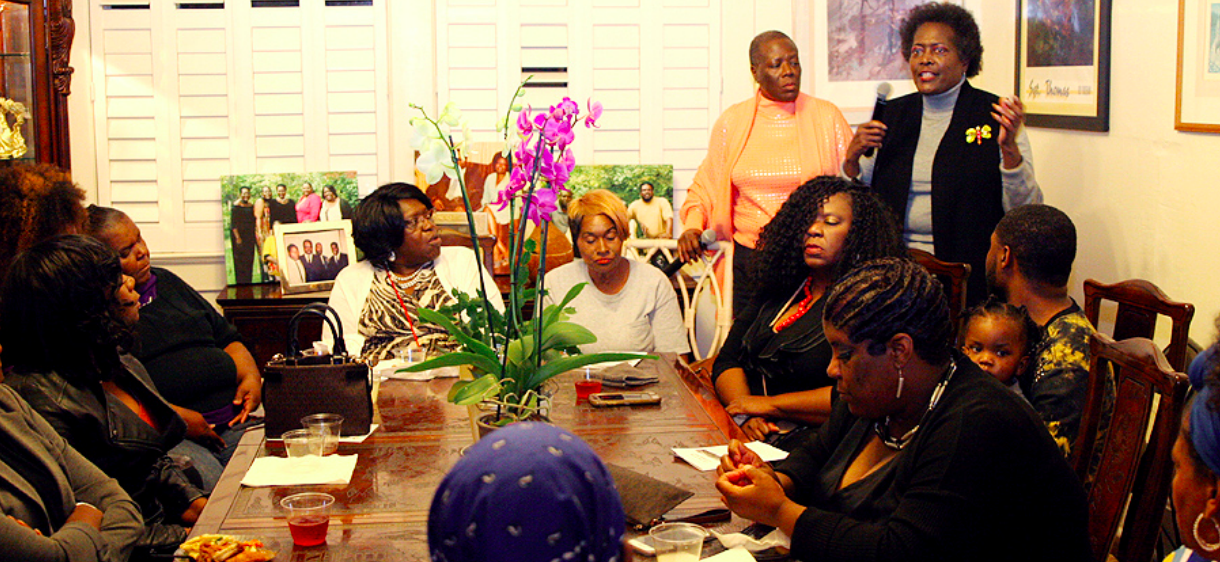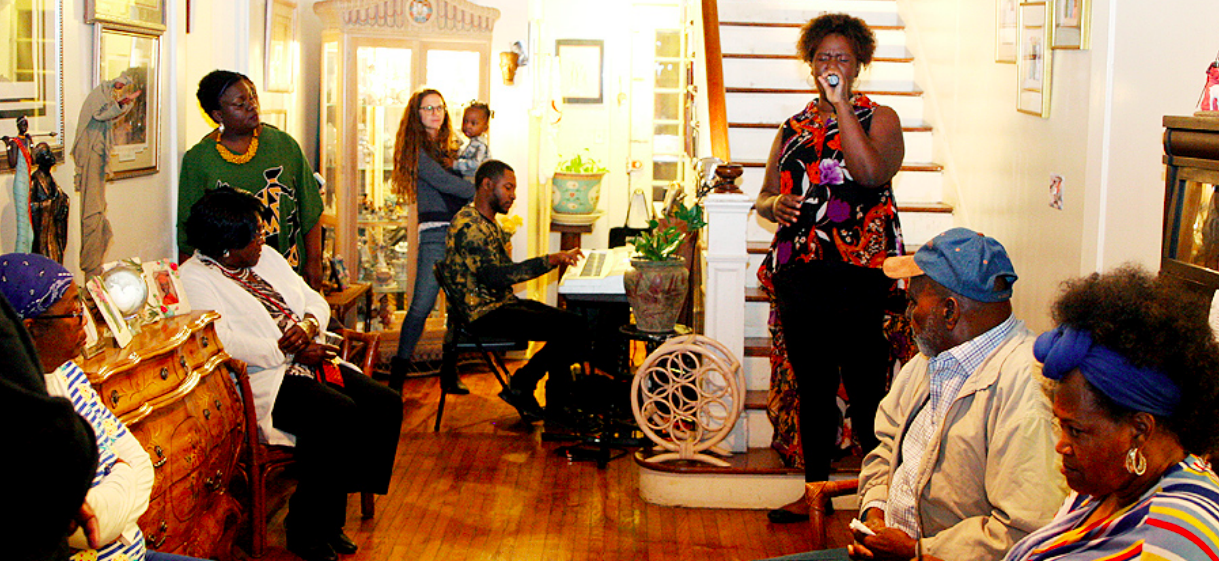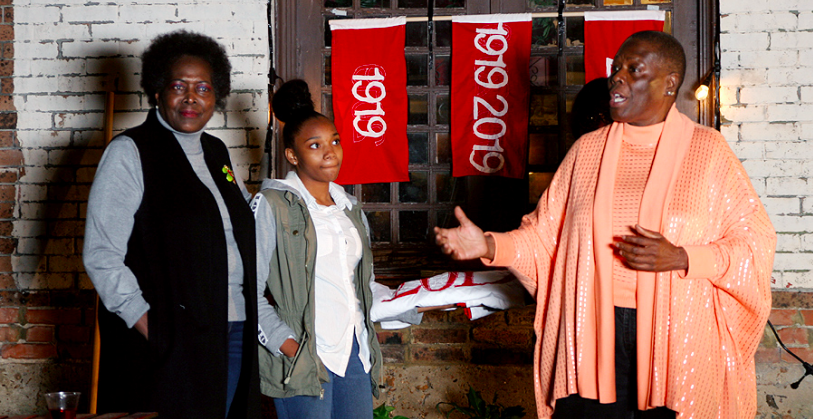
Yazmany: My name is Yazmany Arboleda. I'm a member of the collective Remember2019, and we're here in Faye Duncan Daniels' home on the morning of-
Mauricio: Friday, September 27th.
Yazmany: That's right.
Mauricio: Day two of the Black ‘n da Blues tour.
Yazmany: Beautiful, yeah.
Mauricio: And today we want to start out our conversation with Yaz about aesthetics. Yaz, who carries the aesthetic, often vision of this project. What is aesthetics? Help us understand what you understand and define as aesthetics.
Yazmany: Yeah, I think it's important to note that when I think about aesthetics, it is... Whenever I'm invited to any community, anywhere in the world, in my practice, I always think, who are we here and how do we make ourselves manifest? And when I think about aesthetics, aesthetics carries with it the notion of what is it that we see? It's the aesthetics of a flyer. It's the aesthetics of a room. It's aesthetics of how do things appear to human beings? Taking into consideration how someone is being introduced to an idea, to a space, to a notion. And anything that deals with that aspect of a humans experience is deeply what I'm interested in.
Mauricio: And so we're in the middle of our Storybank series, and you created the image for callin' down the road. What were you trying to communicate with that? What were you hoping folks would see in that image that you created?
Yazmany: Well, when I think about the Storybank, the first thing that happens for me, it's more around the notion, and I think I spoke to Arielle and Carlos a lot about this, the idea that this thing, this visual was going to be around people as they told their stories. I thought about what are the chairs, what is the table, what are the aspects of what's going to make someone really comfortable sitting and having a really honest conversation? Because of the nature of what we are naming, which is a massacre, I wanted to use the color red very obviously, like the notion of blood, of that deep saturation that speaks to what we often think about violence or love. Both of those things to me exist in that color. And so the aspect of how do we create a room using a couple of chairs and a banner that lets somebody know that they're actually walking into a space and being a part of a conversation that is meaningful. When I think about the font that was selected – magnetic, it's boxy, there's aspects to that that make it feel kind of mechanical, and it's the way that the curves of its letter exist or were designed.
Really thinking of how do we create informed spaces so that people are walking in and are thinking, "God, this was considered. This was something that was thought out, and it feels..." Just like everything else, when I think about our flyers, I think, "Goodness, how does somebody see one of our flyers and think, 'This is something that's important and cool and has a level of sophistication and care and I want to be a part of that.'" And so often to me is how do we make these things feel like they are inclusive and they are inviting to anyone.

Ashley: The one thing I love about your work too is you show such respect through your design. So you say to the community, "This is a professional artistic experience and we are holding this work, we are valuing this work on that level of professionalism and respect." You care about making sure that there are streamers and that the pictures are perfectly mounted and there's respect in that, in that artistry.
Yazmany: Well, I think that's the proposal - that we're creating and crafting things for the communities that we're working with that effortlessly show those communities that we care about how we approach and how we show up, all aspects of what we're doing with them. When you think about showing up and having a gift for someone or showing up and having prepared a meal, it disarms people because it opens them up to be their warmest, kindest selves in relation to the work you're dealing with together.
Mauricio: Yeah, so you mentioned meal, and you mentioned a kind of care or like a sophistication and I wonder, one of our values is cultural specificity, right? And we've been talking in general about communities, and obviously your work across many communities is robust. But speaking specifically about Phillips County and our work here, what is your thought about, as you craft these things, what is your process around making sure that that meal is specific to the community we're in conversation with? Because you and I, as Colombian-Americans, we might like a little something that's different, right? So how do you consider your own biases when it comes to your aesthetic preferences in Phillips County? Like here now?
Yazmany: Yeah, oftentimes when I show up at a place, I spend a lot of time absorbing the environment, aesthetically. Like, what are the prevalent colors on main street? What are the main colors down in Helena, West Helena, or what are the main colors in Marvell that appear on houses and on artwork? What are the different things that people are surrounded by so that we can create things that are going to be in contrast to that a little bit. Because oftentimes I'm really interested in creating a point of view that feels a little bit different and actually alters the way that somebody is going to behave, and it's going to shift them away from what they know and are comfortable with. And it's about that finding balance. I lean in and try to understand, and I have conversations with people so that it really comes from the people we're working with.
When Mauricio first called me in 2015 and he asked me the question, he was like, "Oh, I just heard Bryan Stevenson's speech. And it's really important that we memorialize lynchings and all of these spaces across America that have been unnamed." And immediately the question that came to me at that moment was, "What do scars look like on the earth?" When I think about the cotton fields, when I think about all of these roads that we navigate and that we spend so much time in, in Phillips County, what is that manifestation of pain and of hardship that come along with these really hard realities? How is there a way of memorializing in physical space? What does that look like? And so immediately I thought about gashes on the earth. And I remember thinking about, are those metal gashes? What is the materiality of them?
And then when you come here and you begin to realize that through a process of investigation, people actually don't know about these stories. And so how do you begin to think through the physical manifestation of the space to make room for connections. Because a huge part of the way that I approach my work as well is, yes, two chairs and a table make space for two people to have a conversation. How to we arrange space so that people can be in relation to each other in ways that allow for change to happen and for transformation to occur?

Carlos: Yeah, I think along the lines of this question that Mauricio asks, talking about cultural specificity and kind of thinking about cultural specificity in form in the way that you work, I wonder how would you articulate your aesthetic lineage?
Yazmany: Being Colombian-American and doing this work, I think that there's part of this that has been really a beautiful journey for me in that I spend a lot of time serving ideas that are outside of my wheelhouse. And that serves me as an artist, expanding the way I think by being here with the Black community, supporting Black artists who are interested in these narratives and enabling a new way of thinking. I find so often we are so segmented and there's such limitations in the way we approach each other as people who look differently from each other, as people who come from different backgrounds.
I'm really interested in forms that heal and connect people authentically across races, across languages. How is it that we as human beings connect to each other and see each other connecting in a way that is transformational? I was born in Boston, but I grew up between Colombia in Medellin and Fort Lauderdale in South Florida. My father was assassinated when I was 11 years old and two of my uncles were tortured to death, and that's been a part of my life's work to investigate these happenings and to understand how my family covered up, didn't cover up, forgot, suppressed so much of this trauma to get to a place of healing.
And a huge part of what we're doing here as, as a collective of artists is that exploration. And so when I think about that blood red, it is my blood red and it's also this community's blood red. When I think about 1919 and what happened here and all of the ways of approaching history, I think about my own family. So it's been really beautiful for me to go through this process and to be a part of these questions.
Arielle: So one of the things that I've encountered and noticed about your work is that it's very kind of vibrant. And so the use of these primary colors, the reds, the yellows... I'm thinking about the blue in Black ‘n da Blues. And with this project in particular, this blue and this red and white gives me an America, not as we kind of imagine it, but like another vision of a reworking of colors. And so I think you talking about this wound and it opening up or like scar, you said, and could you talk about primary colors a little bit and how that works or how that can hold dissonance and complexity?
Yazmany: Yeah, I think we go through life not really noticing how much color affects the way we live, actually. And I'll give you an example. When I was working and living in Afghanistan in 2013, the color pink, which was the color of the 10,000 pink balloons that we gave away to call attention to different questions that the youth activists I was working with were naming. And in a construct where the cities often... The color of Afghanistan it's like a light brown. There's dust everywhere. The dust of the desert comes in and kind of tries to take over the city every morning, and every morning you see women and people brushing it away. And I think in that construct, pink was a color that was unusual and that felt rare.
So when I think about primary colors and red and yellow and all the different colors that I've used in my practice over the past few years, I think it's about creating objects and spaces that feel a little bit childlike. There's a playfulness to them that allows us to connect and be disarmed. And I think, again, understanding what a community's dealing with, what they see every day, what they encounter, what are the normal color of cars or other objects in the community, and how do you use that as a way of creating a contrast that's going to say, "This is a little different, and you're going to experience something that's unlike something you've experienced before."
It's about creating space. Space can invite, invigorate, disarm, welcome. When I think about the show Black ‘n da Blues and I think about what Vera is wearing... We've never really directed them to wear anything specifically.
Mauricio: The direction was, wear what makes you feel beautiful.
Yazmany: Exactly. Beautiful, which is exactly right. As long as those artists are comfortable and they're performing their truths, how amazing, right? And so when I look at Mookie, and he's wearing those flip flops with socks and a tropical floral top and some khakis... Beautiful Mookie, right? That is him being comfortable.
And! He is wearing, what? Cotton, right? When I think about all the stories that I've heard of the South and how important cotton was to the economy of the world in the early 1900s and how that... The reason this community is dealing with the challenges that they're dealing with is because the cotton, the machines came and took away all these jobs and the economy shifted. And so not only for me are these cotton plants, which are so stunning aesthetically because of the idea that cotton's coming out of the earth and those little balls. I don't know, to me there's something so mystical because it's so round and it feels so... There's something about the plant that feels so unusual to me as someone who hasn't ever been... Until I came to this place, I had never been with cotton plants among them. I had never touched them.
I remember last year I went and took a few and undid them and undid cotton from the seed and was just so intrigued by how beautiful these little bulbs of softness. It was just such a beautiful aesthetic in and of itself, and then the fact that it's connected to this incredible history. And then it makes me think about Faye yesterday, sharing with me that she was five years old and she was picking cotton at the age of five. And that actually all those scratches that she was getting as she was walking through those fields, picking the cotton because she didn't have an option because that was what her mother had asked her to do. I think about how beautiful the plant is and how harmful it was to her skin and that relationship. And so there's a lot of layers to it, beauty next to pain, history, heartache. And all of that is tied together, for me.
